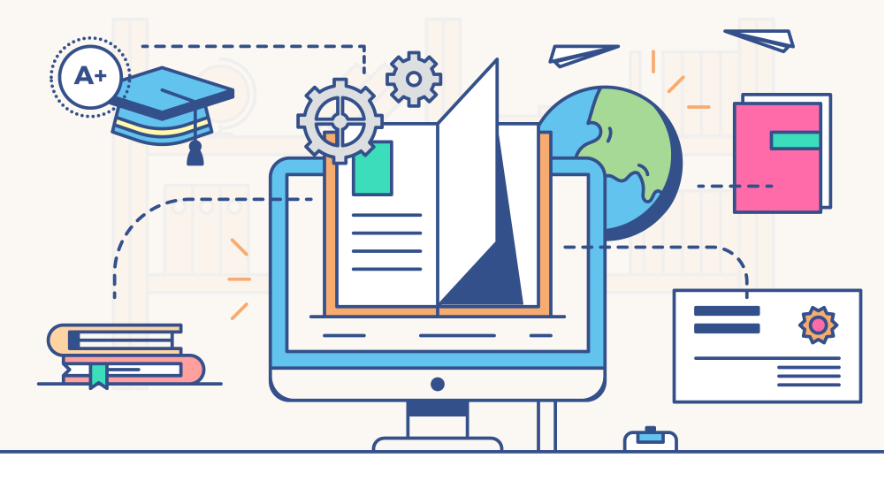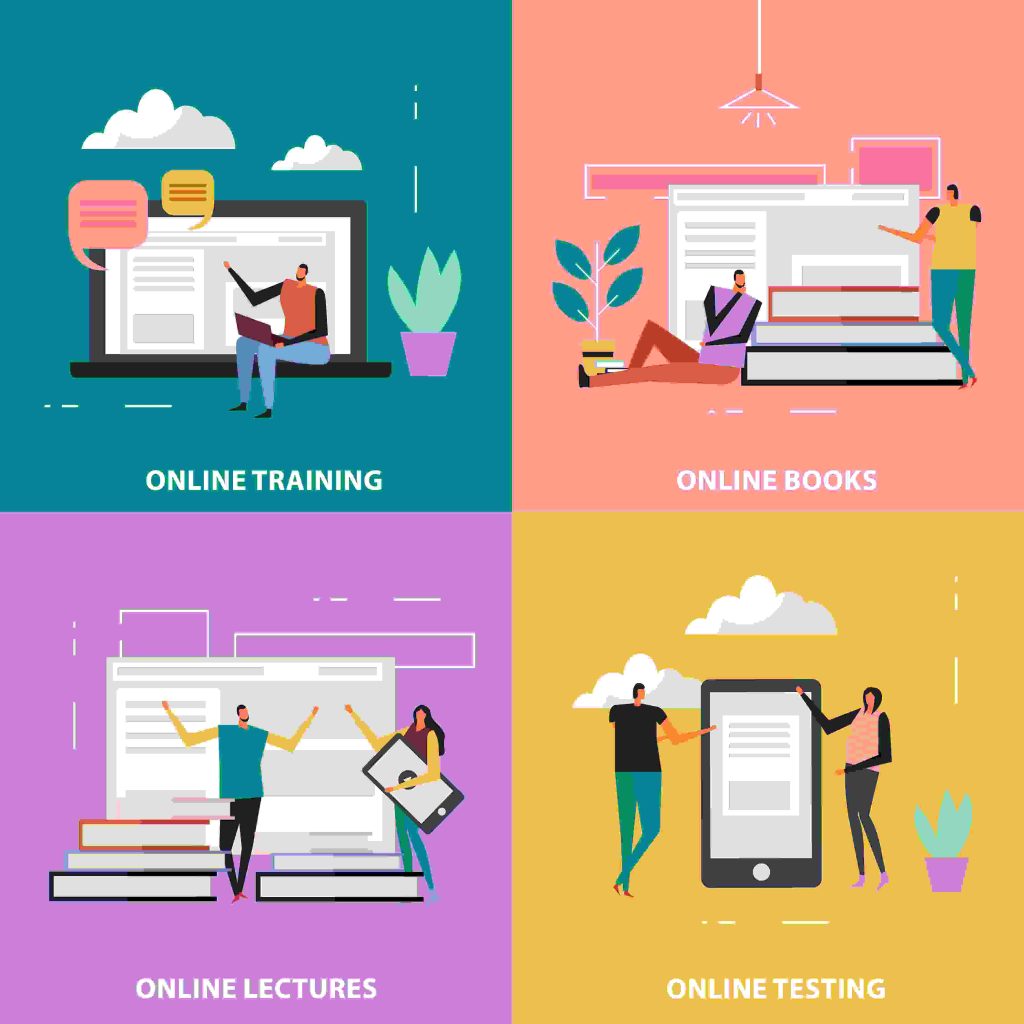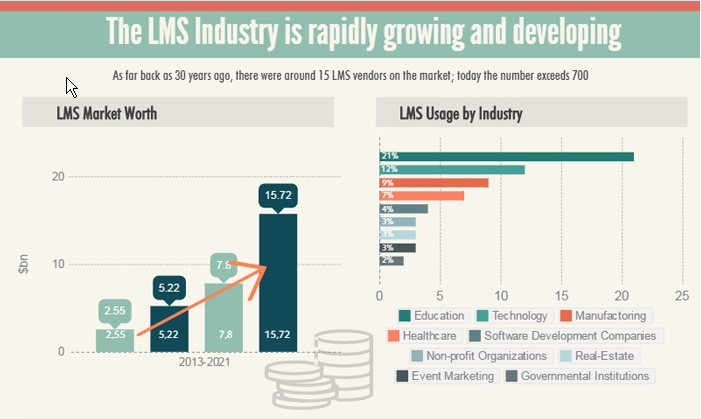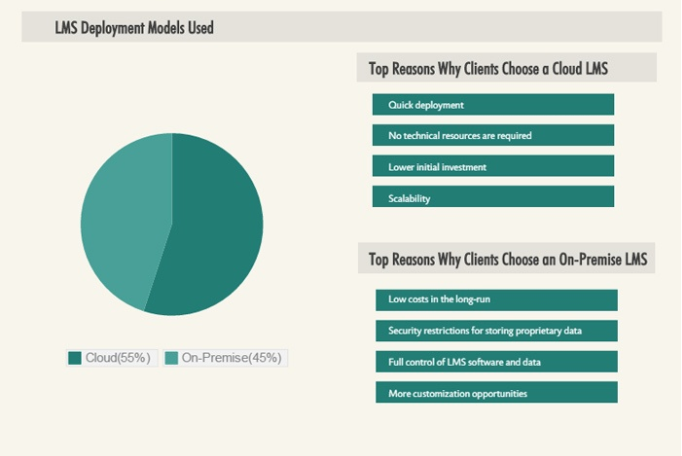What is a Learning Management System? – A Complete Overview on LMS and its Applications
13 Jan 21 

COVID-19 is not just disrupting the “grown-up’s “life.
It has put more than 1.2 billion children out of school worldwide.
As various governments try to implement their social-distancing measures, closing down schools and colleges was one of the first moves.
As every coin has two faces, this situation has its other side too, for example, the World Economic Forum, sees this as a defining moment in the history of human education.
Because the learning has not fallen as we thought, it might.
Powered by different learning management systems and software the advanced innovations in the Information and Communication Technologies (ICTs), mobile app development and internet-led technologies our kids are continuing to learn as effectively or more online.

What is a Learning Management System?
A question which has become very prominent now.
Because parents, educators, etc. are looking for a way to facilitate learning at this hour.
But there are two answers to the question: one the simple one and a little technical one.
Learning Management System for Everyone
An e-learning system has three main pillars :
- Course – A course includes study materials in the form of videos, pdfs, docs, etc.
- Tool – a tool is a software that helps to develop these course materials. It is popularly known as e-learning authoring tools.
- LMS – It is a software that helps to deliver the courses to different learners. So it is the connecting tool in an e-learning ecosystem.
Learning Management System for the Sophisticated
It’s a bit technical definition, but you can digest it if you have had a dose of basic computer science degree.
Here it defines an LMS is a software that helps to create, manage and provide e-learning courses effectively ( just like we saw before).
An LMS will have two parts viz. are :
- A server part that handles the core functions of the creating, handling, delivering courses, sending push notifications, providing data and authenticating users, etc.
- A user interface component that runs within the web or mobile application which lets the user (student) or the administrator (the organizer or institution) handle the various elements of the internet or mobile app.
Being a fundamental component of an active learning strategy, an LMS can be used to deploy a multitude of learning techniques.
It does it through social learning, formal and experiential methods of learning, managing certification for each type of courses, setting the criteria for it; changing and updating them over time.
It is the best way an enterprise or an educational institute can leverage technology to generate revenue as well.

An example can make things much simpler for you.
Imagine you have identified a lack of skill in your sales team.
You want to improve their communication skills in English and Spanish, where your business is located.
You create modules and lessons for six months.
Now how do you conduct the class practically and transfer study materials?
How do you ensure that they have received it and are working on it every day?
That’s where Learning Management Software comes into being.
An LMS here acts as a connecting platform to share the daily lessons, work materials, homework.
The employees can submit their daily works, and the course coordinator can check them.
With a single click, they can send the documents to all the participants and hence save time and resources.
Who Needs a Learning Management System?
There is little doubt now that LMS now needs to be the backbone of every institution aspiring to deliver quality and continuous education.
The reason is COVID-19 is a reminder of the fragile nature of our gatherings.
Post COVID-19 world is going to go for a more healthy social distancing option whenever possible.
LMS is must if you are into some form of training activity, it doesn’t matter whether you are a :
1. Large Enterprise
Enterprises who are running massive training programs and are providing educational services also can benefit from LMS immensely.
Globally operating enterprises can sync their training sessions across the globe with powerful learning management system.
2. Medium Business
Medium businesses also stand to benefit a lot in terms of cost of operation and conduct.
Because for medium enterprises, training is an essential part of growing further.
They are already at a place where they have only slight margins of profit and competence with similar competitors.
Skilling their human resource hence is the only masterstroke they can play to get higher dividends and enter the ranks of the elite companies.
3. Small Business
Small businesses are always on a lookout for cost-effective solutions to build their capacity and expand.
An LMS is the best way to reach maximum clients in a single shot and yet save on classroom rentals, teacher fees, etc.
4. Freelancer
You might wonder where the freelancer fit into the picture?
It is in the number of clients they have difficulty in managing them.
A freelancer can attend to multiple clients with an LMS.
She/he can drop off the files, docs, pictures, designs, etc. with a single click into the client and save time and shed misery.
What are the Uses of an LMS?
An LMS finds use in a multitude of things.
As we already saw, an e-learning management system is the heart of every e-learning programme.
However, there are different models of LMS viz. are cloud and on-premise.
As you can see below, the cloud is more popular among small emerging companies as it is economic.
But the size of the company is a decisive factor in this selection.
Because an MNC or large institution can benefit tremendously by going on-premise as the cost of setting up it is minuscule compared to the returns it brings as an actor of numbers.
Now coming to the uses to which you can put your LMS to we see that they serve the following purposes :
1. Distant Schooling
A way to conduct classes, deliver courses, materials and other essentialities during vacation, pandemics or to promote education in places with poor infrastructure.
2. Employee Coaching
Skilling your employees or giving them specific training.
LMS can help arrange the classes, distribute the learning modules and test them for progress.
3. Extended Training
Providing vital know-hows on your product to third party organizations or to staff to whom you have outsourced your projects, the scenario is vast in the present context of open economies.
4. Instructing Clients
Innovative products need updated users.
Delivering products that are new to customers, you may need to train them on some more delicate aspects.
For example, suppose you are providing a mobile restaurant app.
Your client will need training on how to use the backend, check for parameters, enter codes if any, etc.
LMS helps in all such learning necessities.
What are the Different Types of LMS?
Though the main goal behind every LMS platform is to facilitate learning, there are several ways in which these are implemented.
This gives rise to different types of learning management systems.
Depending on your goals and requirements, you can choose the type of LMS you want to implement.
1. Free vs. Commercial
When choosing an LMS, it might get confusing to decide whether you should go for a free one or a commercial one.
There are a number of free, open-source learning management systems in the market.
Most of them provide a good number of features as well.
However, it would require some technical talent to deploy free LMS.
It is a good option if you are a small company with a tight budget and have good internal talent.
Commercial LMS are designed for bigger companies with many users.
These are easy to deploy and will have assured service at their disposal.
Commercial LMS receives constant updates so that it always remains on top of technological trends.
Depending upon the required features, the price of commercial LMS will vary.
2. Corporate vs. Academic
A learning management system can be used to train employees of an organization or for academic learning purposes.
Corporate LMS are used by businesses to train their employees, partners, or clients.
These could be onboarding training, customer training, compliance training, etc.
In corporate LMS, training content is more practical and needs to be updated frequently to reflect market changes.
Academic LMS are employed by schools, colleges, or universities to provide students academic training.
Here the content is determined in advance, and don’t need frequent updates.
They also have less technical requirements and don’t have to be very feature-rich.
3. Cloud vs. Installed
Cloud-based LMS solutions are gaining popularity today because they do not require much effort on setup and maintenance.
They also make a cheaper and more convenient solution as compared to Installed softwares.
The flexibility, scalability, and upgrade options make it an attractive LMS type.
Installed LMS are like traditional softwares installed on specific organizations’ servers.
It can be limiting and expensive compared to cloud-based LMS, but it is generally deemed more secure.
It takes more effort in installation and maintenance but gives extensive customization options.
4. SaaS vs. Licensed
Saas solutions are out of the box solutions and are mostly cloud-based.
Technical support is made available for these solutions throughout the usage period.
These solutions are scalable and always ahead of upgrades.
Saas solution is the best choice if you don’t have IT resources to spend on handling the platform.
Licensed solutions are customized solutions that are built according to user preferences.
These can either be set up on cloud or on-premise.
But their development and updations take a lot of time.
In terms of customization, customer support, security, and reliability, licensed LMS solutions are the best choice.
5. Integrated
These are the LMS softwares that integrate their working with the existing softwares or systems running in an organization.
Integrated LMS is very beneficial in enterprises as it enhances the learning experience of its users by connecting the learning platform with other useful tools.
How a Learning Management System Works?
So how does one get started with a learning management system?
What are the steps to take to create a learning atmosphere?
Let’s take a look.
1. Create Your Content
The elixir of a learning management system is the course content.
So the first step is to create this eLearning content and add it to your LMS.
How do you do this?
The course content can be created either from scratch- by writing out every lesson- or using existing resources like word documents or articles from the internet.
It is essential to check what types of content your LMS supports, like audio, video, images, etc., and choose the formats accordingly.
2. Structure Your Courses
Depending upon the needs of your LMS and the structure of your organization, you would need to organize your eLearning courses.
Your LMS can either offer a single course or multiple courses depending upon who your learners are.
For student groups across branches or organizations across departments, LMS would require delivering numerous courses for each set of learners.
For complex courses, it is ideal to create a learning structure with a connected flow to maintain consistency throughout the course.
3. Connect to Your Learners
Once you have created and structured your course, it’s time to meet the learners and impart your knowledge.
Your audience can be a large group or small, depending on the course.
It might be for a selected audience, or it could be for everyone.
Whatever it is, the LMS you have chosen must be able to provide the settings you need.
The LMS platform should be responsive to accommodate mobile users, have an integrated payment system for paid courses, be scalable depending on the audience number, etc.
4. Assess the Results
After you have started delivering the course, evaluating the results helps in bettering the service you provide.
Most LMS systems have tools to track the progress of learners in real-time.
This gives information such as how much time they have spent studying, their progress, etc.
These detailed statistics can help the teachers plan their courses accordingly.
How to Know if My Organization is Ready for an LMS?
You can see that an LMS simplifies the administration, reporting, assessment and documentation of your school’s or organization’s learning processes.

One of the frequent scepticism associated with adopting an LMS is that it is very costly and that the whole process of election is very time-consuming for the companies.
But our experience reveals that if you want to succeed, you need to take the risk.
Many organizations like to conduct meetings and brainstorming sessions with little intent for action on the outcomes.
We would say that if after you analyzed needs and requirements, you have concluded that your organization needs the following, then you need to get an LMS.
You are ready and in need of it. The requirement list includes:
1. Easy Administration
To manage your course catalogue, enrollments, instructors, classrooms, projects, assignments, etc.
2. Enhance Learning
Build modules and design courses in your online LMS system for schools and organization to promote more significant learning among students or employees.
3. Full-time Accessibility
Build e-learning courses that are accessible anytime anywhere with simple credentials.
4. Comprehensive Solution
You need to connect throughout the organization and across various departments and employees.
5. Consistent Training
Want your training programs to be consistent and employees getting standard materials for learning and working out objectives.
6. Tracking and Reporting
If your institution wants to calculate the ROI in the education app development investments, employee progress, etc., and need to furnish reports to the administrators and board of directors and authorities.
7. Cost Saving
Need to bring out a learning management solution that is not hefty and meets your requirements at the same time.

What are the Essential Features for a Learning Management System?
A great learning environment is one that is responsive to the needs of its users.
An LMS software must have all the essential features that make the users feel satisfied with the platform and help them experience an incredible learning journey.
Here let’s take a look at 14 excellent features for a learning management system are:
1. Easy User Interface
The user interface should be easy, intuitive, and guide users in an uncomplicated manner.
If users have to spend a lot of time learning how to use the LMS before they start learning their course, it will put them off the learning process.
2. Simple Login
A simple, central, and to-the-point login portal for all the users to log in and perform their tasks.
This includes learners, admins, and course creators.
3. User Management
A basic feature to add users, edit user details, and categorize them into appropriate sections.
4. Course Management
Which course goes to which learner?
How to deliver it?
Course management takes care of questions like these enabling the LMS to provide a targeted learning method.
5. Automated Tasks
This is an advanced LMS feature, which helps to automate repetitive tasks such as user grouping, enrolling, or course creation, categorization, etc.
6. Personalized Learning
Another advanced feature, this involves using AI in the LMS to offer personalized content to learners.
This makes learning interesting, easy, and an immersive experience for its learners.
7. Gamification
This is a basic feature to keep learners engaged and motivated.
Gamification elements like points, badges, or awards can help learners set goals and track their progress.
8. Mobile Learning
The LMS platform should be mobile responsive so that it can be accessed from anywhere and at any time, regardless of the type of device.
It is a necessity in today’s times.
9. Social Learning
Social learning is an advanced feature that lets learners build a great learning atmosphere by sharing knowledge.
This can be by publishing articles, or through discussion forums, etc.
10. Reports
LMS should be able to create reports based on learner activities.
These reports and the insights from them serve as useful metrics to measure the effectiveness of learning.
11. Live Classroom
Having provision for virtual training sessions, webinars, etc., makes an LMS more effective in cases of remote learning and helps everyone involved to interact more through audio and video.
12. Integration
Integration of LMS with other third party systems or softwares in the organization leads to a synchronized atmosphere and helps in the overall betterment.
13. Certification
Awarding learners with certificates upon completion of courses motivates learners and lends a professional air to the learning environment.
The platform should also give admins the option to track certification processes.
14. Notifications
An essential feature in LMS, notification helps users keep up with their tasks like assignment submissions, upcoming class schedules, etc.
Benefits of Using a Learning Management System
An LMS can serve your organization in many different ways.
Let us look at the advantage of having an LMS in your company or educational institution:
1. Saves Money
Nothing can be more attractive in the post COVID era than economic and smart solutions to technical problems.
LMS is one of them as it cuts on the cost of training involved in transportation, training days, printed materials, location hire, etc.
2. Better Allocation of Resources
An LMS system helps you in pinpointed channeling of resources.
Dispatching new sessions to employees, ensuring distribution of study materials or training modules, etc. an LMS acts as the central nervous system of e-learning programs.
3. Prevents Time Loss
When productivity is a significant concern, time is held very dearly by managers and CEOs.
It even leads to a state of paralysis with training efforts being quashed from the management side in the name of productivity.
LMS is a game-changer here.
LMS gives every employee a fair chance at attending skill development sessions.
One can visit them without skipping work hours, even while travelling or during break hours comfortably.
4. More Space for Creativity
The ability to resume materials and the option to digitize presentation and course structure gives more room for creativity with an LMS.
Trainers and teachers can try methods and track their efficacy and then modify them without disturbing the course using learning management system.
5. Automate
One of the greatest needs of a trainer is to ensure that they keep the students, trainees engaged.
Free educational apps have succeeded tremendously in this aspect of education.
Keeping things interactive and alive, they always motivate learners into action.
LMS is very advanced in this front as it can automate alerts and with proper integration, alert people through push notifications and other social media tools as well.
6. Assessment
Report cards can be easily tracked with LMS.
The centralized repository of student data helps trainers to publish report cards in innovative ways.
They can create competitions, point out even the minutest mistakes through data analysis and much more.
How to Select the Best LMS?
Selecting a learning management system out of all the various options available in the market can be challenging.
So how does one go about it?
How to find the best LMS for your needs?
1. Know Your Needs
The best LMS for you is the one that meets your needs.
So before choosing a system, it is ideal to identify what your requirements are.
Ask yourself what the purpose of your LMS is.
Define your goals clearly, in a quantitative manner.
Know your resources, your budget, and plan on how you can achieve your goals with what you have in hand.
For example, if you have a tight budget, choose an LMS with basic features that will meet your goals.
2. Know Your Audience
Who your audience is gives a lot of information about how your LMS should be.
Are they youngsters or adults? How tech-savvy are they?
Questions like these will help you clearly define the technical requirements of the LMS as well as the learning structure you need to provide.
It helps you choose an LMS that is not intimidating to the users but rather engaging and involving.
It also enables you to define your learning strategy accurately.
3. Inspect the Market
Once you know the goals of your LMS and features, it’s time to dive into the market and explore all the available options.
Enquire with people who have hands-on experience, read reviews, testimonials, and case studies.
Find out what other users have to say about the different systems.
Look out for reviews by companies that are similar to yours in strength and goals.
It will give you an accurate idea of how well a particular LMS could meet their needs.
That will make it easy for you to shortlist options for your LMS.
4. Test the LMS
What’s a better way to find out if an LMS matches your requirements than trying it out?
Most LMS offer a free trial policy for 15 days or one month.
This is a great option to verify all the features of an LMS without bearing the burden of an overhead pricing plan.
You can check whether it is easy to use, has a user-friendly interface, if it meets your technical needs, the extent of support offered by vendors, and just test all its capabilities.
You can try 2 or 3 LMS platforms for free and choose the one that is the best fit among them.
By following these steps, you will be able to choose a learning management system that is the right one for your needs.
Conclusion
The opportunities of LMS systems in education and industrial training are immense.
It all depends on how one uses the courses to develop amicable and practical solutions through e-learning apps.
Many mobile app development companies provide partial designs for your e-learning platform.
But it is always wise to go for the one that sees your problem through a comprehensive outlook.
Mobile app ideas are here to keep life ticking and moving.
Mindster has a decade-plus experience in crafting apps for many top brands across the industries like Oman Air, Edenred, etc. Leverage your business with our impressive e-learning apps and LMS.
- Agentic AI1
- Android Development3
- Artificial Intelligence31
- Classified App3
- Custom App Development5
- Digital Transformation12
- Doctor Appointment Booking App14
- Dropshipping1
- Ecommerce Apps40
- Education Apps2
- Fintech-Apps37
- Fitness App4
- Flutter4
- Flutter Apps20
- Food Delivery App5
- Grocery App Development1
- Grocery Apps3
- Health Care10
- IoT2
- Loyalty Programs9
- Matrimony Apps1
- Microsoft1
- Mobile App Maintenance2
- Mobile Apps127
- Product Engineering6
- Progressive Web Apps1
- React Native Apps2
- Saas Application2
- Shopify9
- Software Development3
- Taxi Booking Apps7
- Truck Booking App5
- UI UX Design8
- Uncategorized6
- Web App Development1

















Comments